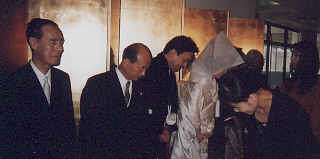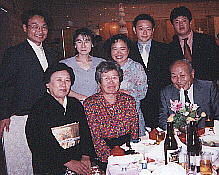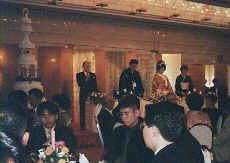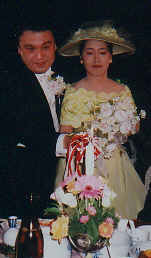 | My cousin Takeshi (left) is the son of my father's oldest sister. He has been able to live his whole life in the city where he was born, the picturesque and historical Nagasaki, on the west side of Kyushu island in southern Japan. We are the same age, so by looking at his life I can get an idea of what might have happened to me had my parents never emigrated. He has worked in the accounting department of a food-related company for about ten years now, and decided to get married this year. His wedding is the first amongst the male grandchildren in our extended family. |
Kekkonshiki: A Japanese Wedding
The wedding ceremony and reception were held at one of many hotels which specialize in just those things.
| That hotels can thrive in a niche market like weddings is a testament to the power of the wedding industry in Japan. The social pressure on young women (and, to a lesser extent, men) to marry is intense. Young people today are resisting tradition. |
Having checked in the night before, we had time for a leisurely breakfast and morning sampo (stroll) before having to get ready for the ceremony, which was held around noon. I had brought a nearly correct dark charcoal suit to wear (completely correct would have been a black one). I had also specially purchased what I considered to be a nice patterned gold-colored necktie for the occasion, however I was instructed that it was not appropriate. :p Luckily my father had a spare white tie.
| In Japan, for happy occasions like weddings one wears a plain white tie. You should also keep a black tie in your locker or desk drawer at work, in case you suddenly get called go to an ososhiki (funeral). |
| The wedding ceremony was held in a part of the hotel which had been converted into a Shinto shrine. It was a small room, with the altar at the end opposite the door, the priest and the shrine maiden in the middle, and seated in front of them the bride in a pure white kimono and and headdress, and the groom in a haori. A row of about ten relatives from each side was seated along either remaining wall. The priest performed the ancient rituals to music from the Heian Period, familiar to me from having seen the historical films by Kenji Mizoguchi last year. It was only a cassette tape, but I felt a connection with the past -- that is, until the shrine maiden abruptly hit the "STOP" button. | No photo here, partly because I didn't want to be disruptive, but mostly because it was so crowded that my arms were pinned to my sides! |
The bride and groom said their vows, sipped sake (three times) and exchanged rings. We relatives toasted the newlyweds, sipped sake and were introduced to each other by the two fathers. The entire ceremony seemed to only take about half an hour. Then it was out to join the other guests for the obligatory kinen shashin (commemorative group photo).
|
For Western weddings, more people are often invited to the ceremony than the reception --
churches are big, and dinners are expensive. In Japan, only close family can fit into the room
where the ceremony is performed, while more people can be seated in the banquet room.
It's the opposite! Well, almost -- the meals are still expensive.
|
| The next stop was the hotel lobby, where we signed the guestbook and presented our gift money - crisp, new bills in special envelopes, as dictated by protocol. I signed my name and city of origin, but was later told that it is customary to write the city first then one's name. :p |
| There's no worrying about bridal gift registries in Japan. Just bring cold, hard cash, and more of it if you're a close relative! In return you'll receive a nice gift from the newlyweds. |

| After signing the register, we headed for the banquet room. At the door was the receiving line of the newlywed couple, their parents, and the nakohdo (endorsers). Everyone bowed and most said the kimari monku (set phrase) for an occasion like this, "Honjitsu wa omedetou gozaimasu (Congratulations on this happy day!)." |
| In Japan, there is a prescribed behaviour and phraseology for most every situation. It's not genetic, it's learned, these days increasingly from books. Sanseido's book "Kimari monku no jiten (Dictionary of Common Phrases)" was a bestseller a few years ago. No Japanese wants to suffer the embarrassment of saying the wrong thing! |

| It took a little while for the 150 or so guests to find their places. Each table was named after something nice: Money, Happiness, etc. The head table consisted of the newlyweds and the nakohdo. The newlyweds' parents sat with the rest of the guests. |
|
For omiai (arranged marriages), the nakohdo (go-betweens) are the matchmakers who
introduce the couple to each other. In these days of marriage-by-choice, nakohdo are instead the people who
endorse the prospective couple's union for the official record. The honour is usually bestowed
upon two respected older family friends or former teachers or bosses. Omiai still happen
in today's Japan, but are definitely a small minority.
Japan: Moving from Arranged Marriages to "Love Marriages"? Tying the Knot: The Changing Face of Marriage in Japan |
 | A multicourse meal of sushi, sashimi and other delicious dishes was served, while many speeches were made, using some of the most polite keigo (honorific language) I've ever heard. Speakers included the couple's bosses from work and close friends. |
|
Takeshi's bride is someone he met through his involvement in a swing orchestra that plays
Glenn Miller music (He's the big man on lead saxophone). In a departure from the usual
wedding reception format, Takeshi's band played a couple of numbers.
They sounded great, but they've got to work on how they say "Pennsylvania 65,000"! ;-)
The rest of the music was sappy corporate American schmaltz like Mariah Carey, Whitney Houston,
and Celine Dion (I know, she's French Canadian, but she sings like an American!).
Why Celine Dion Is Quebecoise |

|
Through it all there were about three costume changes for the bride: from a red kimono for the entry (below left) to a Western wedding dress for the cake cutting (below centre) to a Western off-the-shoulder dress for the candle lighting service that signalled the end of the reception (below right). The happy couple was off to Hokkaido for their shin-kon-ryokou (honeymoon)!



|
Although it incorporates many Western elements, the elaborate reception described above could be
called "old-fashioned". Today,
many younger people prefer simpler ceremonies, even getting married in Hawaii or the Caribbean
by themselves or with only their parents and a few close friends present.
Toned-down Ceremonies: Japanese Weddings Enter Age of Tasteful Restraint |
More Links About Japanese Weddings
Japan Guide's Information About Japanese Weddings
About Japanese Weddings and Funerals
Getting Hitched -- Japanese Style
Lance & Sachiko's Wedding
Naomi Gets Married
Hima o tsubusu (Killing Time)
Unlike Western wedding receptions, where the guests can party on until dawn, in Japan events are tightly scheduled and the guests are (politely) asked to leave after about three hours. We took the presents we got from the bride and groom back to our rooms, got changed, did some more visiting, then went out to eat some champon (see "Local Food" below).At a konbini (KONBINIensu sutoah = convenience store) on the way back to the hotel, I bought a hanafuda set. Takeo Ojisan, my father's youngest brother, said he would teach me how to play this Japanese card game. He's taught me other games: shogi (Japanese chess), go. He says he learned them while he was at university.
| Japanese high school students are under extreme pressure to do well academically, in order to gain admission to one of the country's top-ranked universities, where the best companies do almost all of their recruiting. Once their spot is secured, they have what amounts to a four-year holiday until it's time to graduate and start a job. |
Hanafuda literally means "flower cards". The cards are divided into suits represented by different kinds of flowers. There are several games that can be played. One game is similar to blackjack, while another game is something like poker, gin rummy or bridge, with the goal to collect as many high-ranking cards as possible.
Hanafuda sets are how present-day video game juggernaut Nintendo got its start over a hundred years ago. They haven't forgotten where they came from: my hanafuda cards are Nintendo brand! Hanafuda has a shady side to it as well -- it is a popular form of gambling among members of the yakuza, the Japanese mafia. In fact, this is the origin of their name
| Dale Furutani, a Japanese American mystery writer, features hanafuda on his website. |
Nomo at Night
My internal clock had yet to adjust to Japan Time, so I found myself wide awake at 3 am. I flipped on the television to find a live satellite broadcast of a Los Angeles Dodgers baseball game from Houston TX. The reason for the special treatment became apparent when the Astros came up to bat: Hideo Nomo was pitching. Since his debut in 1995, the Tornado Boy has been the focal point of a growing interest among Japanese baseball fans in American Major League Baseball. Another Japanese pitcher, Shigetoshi Hasegawa, started playing in 1997 with the Anaheim Angels, followed by Hideki Irabu with the New York Yankees. The games they pitch in are also broadcast live. Basezzzzzball play-by-play is no more exciting in Japanese than in English. I was soon fast asleep.|
Local Food
Nagasaki champon - A noodle soup with all manner of tasty ingredients (champon = jumble). |
